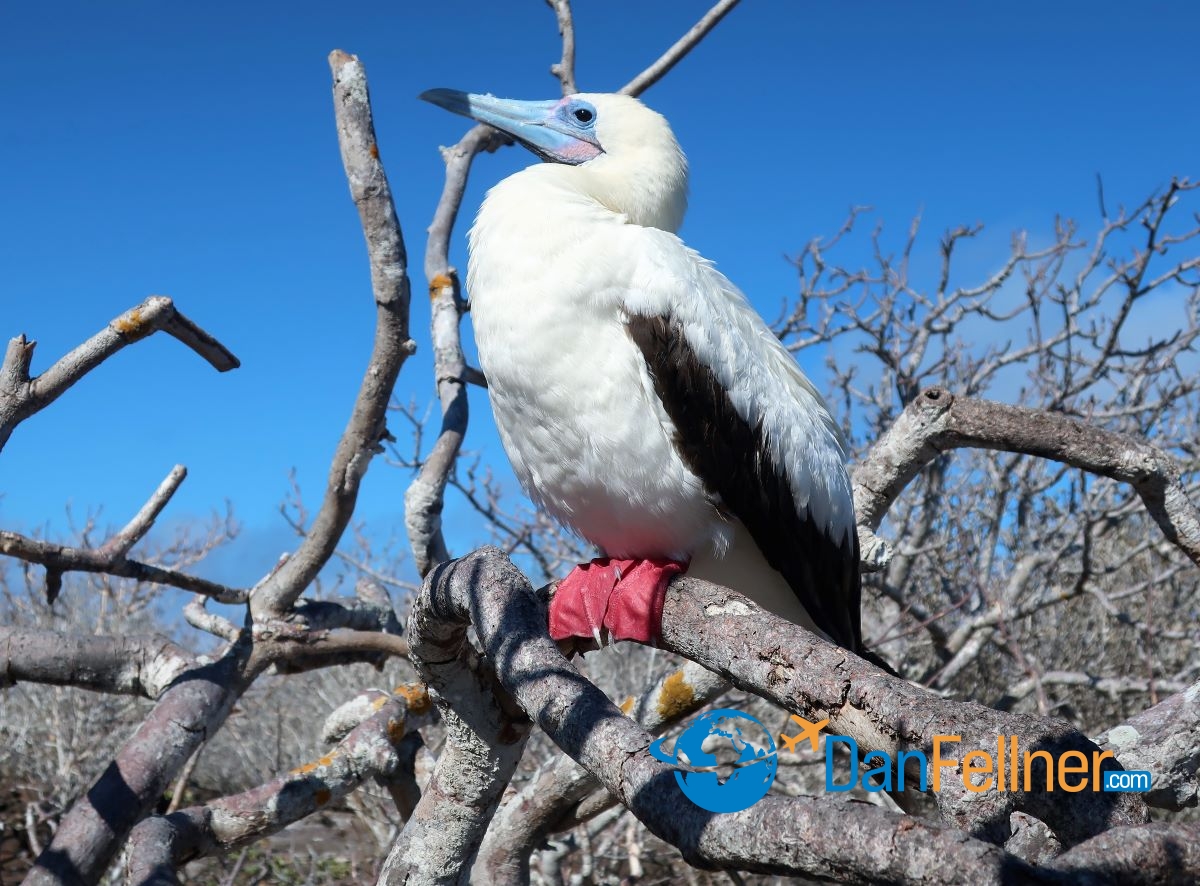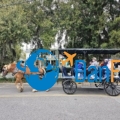South American archipelago a wildlife wonderland
The Arizona Republic/USA Today.com — January 9, 2022
SANTA CRUZ ISLAND, Ecuador – “Work it. Work it.”

A pair of blue-footed boobies perched on volcanic rocks on Santa Cruz Island in the Galapagos.
On a black volcanic rock formation in a remote part of the Galapagos Islands, a pair of resplendent blue-footed boobies need little coaxing from a fellow traveler who wants the marine birds to remain perched while we photograph them.
The boobies are more than happy to oblige. Like runway models, they’re not bashful about posing while our small group clicks away.

The 20-passenger Ecoventura Origin anchored in a cove near Isabela Island, the largest island in the Galapagos archipelago.
With few natural predators, there aren’t many places on Earth where the wildlife is as unafraid – and even welcoming – of human visitors than the Galapagos. The result is an unparalleled chance for nature lovers to see up close everything from 5-foot-long iguanas to pink flamingoes to tortoises more than 100 years old.
If Charles Darwin were alive today, he would find this archipelago of tiny islands in the Pacific Ocean – 600 miles west of mainland South America – little changed from his historic journey here nearly 200 years ago.
It was the English naturalist’s exposure to the rich diversity of wildlife in the Galapagos that led to his revolutionary theory of natural selection. Today, visitors can experience the same access to birds, animals and marine life that Darwin documented during his five-week visit in 1835 on the HMS Beagle.

The Ecoventura Theory cruises past Kicker Rock just before sunset near San Cristobal Island in the Galapagos.
I recently visited six islands in the Galapagos on a one-week cruise aboard the Ecoventura Origin, named after Darwin’s landmark 1859 book “On the Origin of Species.” Our sailing was at full capacity with 20 passengers (all Americans) and 14 Ecuadoran crew members.
The Origin’s sister yacht, the Ecoventura Theory, was often visible in the distance as it traveled roughly the same itinerary. We were on the “northern and western route”; on alternate weeks the two boats take the “southern and central route” through the islands. Passengers can opt to book passage for two weeks to experience both itineraries.

A dinghy ferries passengers back to the Ecoventura Origin after a morning of sightseeing on Santa Cruz Island in the Galapagos.
Twice a day, we were ferried from one of the Origin’s two blue dinghies to an island for a nature walk. Many of these visits involved “wet landings” in which we would step off the dinghy into shallow water and walk ashore. There were plenty of opportunities for snorkeling, kayaking, paddleboarding and viewing marine life on the Origin’s glass-bottom boat.
“You don’t see in other places what you see here,” said Yvonne Mortola, one of the Origin’s two onboard naturalists, who has been guiding tours in the Galapagos for 37 years. “Things happen just in front of you. And it’s safe. None of the animals wants to eat you up.”

A Galapagos land iguana emerges from the brush on Isabela Island in the Galapagos.
If there was any aggression on display, it was between the animals themselves. We watched as a barking male sea lion emerged from a lagoon on Fernandina Island to stake out his beachfront territory, nearly trampling a group of marine iguanas in the process. (see video shot by the author: Sea lion staking his turf on a beach in the Galapagos).
But it was the blue-footed boobies that I found most captivating — not just their eye-catching feet but their friendly dispositions.

Ecoventura Origin naturalist Yvonne Mortola leads a nature walk on the island of Genovesa.
“Blue-footed boobies are just special,” said Mortola. “They’re curious. They have no shame in just walking right up to you and checking you out.”
Governed by Ecuador, the Galapagos consist of 13 major islands straddling the equator. We crossed the equator six times during the trip, stopping each time so the captain could “lift up the line,” as Mortola joked.
Only four of the Galapagos are inhabited by humans; the entire population is less than 30,000. Nearly half live in Puerto Ayora on Santa Cruz Island, the largest city in the Galapagos. During a stroll down Charles Darwin Avenue — the city’s main drag — we needed to step aside for a pair of sea lions, indifferent to our presence as they waddled down the block to the fish market looking for scraps.

A pair of sea lions waddles down Charles Darwin Avenue in Puerto Ayora, the largest city in the Galapagos.
The Galapagos are volcanic islands — there have been eruptions as recent as 2020. We hiked through black lava fields and red sand beaches created from volcanic ash, visited an underground lava tube in the highlands of Santa Cruz Island and sailed at sunset past the dramatic Kicker Rock, the remains of a volcanic cone.
Even though the Galapagos are near the equator, the climate is surprisingly temperate. The cool Humboldt Current and steady trade winds kept high temperatures from surpassing the mid-70s most days, and I needed to put on a sweater when going out on deck to watch the stars after dinner. We were fitted with wetsuits for the week, which helped provide insulation from the chilly Pacific waters while on morning snorkeling trips.

A red-footed booby on the Galapagos island of Genovesa, site of one of the largest breeding colonies of the species in the world.
The remoteness of the islands, which helps to protect the wildlife from predators, makes the Galapagos a challenging destination to reach. There are no international flights into the islands; visitors need to fly into one of mainland Ecuador’s two largest cities, Quito or Guayaquil, then catch a flight into one of the small airports serving the islands.
We flew into Puerto Baquerizo Moreno, the provincial capital city of the Galapagos on San Cristobal Island. There also is an airport on the island of Baltra, the site of a U.S. military base during World War II. Once we left San Cristobal, we never once set foot on pavement the entire week until the final day of the cruise, when we anchored in Puerto Ayora.

A Galapagos tortoise wades into a pond on Santa Cruz Island.
In the towns near both airports, it’s possible to stay in a hotel and take day trips on small boats.
But a weeklong cruise is a far more ideal – albeit pricier – way to explore the remote islands in the Galapagos while enjoying fresh seafood (the ceviche was amazing), onboard lectures and the expansive expertise of the two naturalists accompanying us.

Passengers on the Ecoventura Origin and Theory kayak along a volcanic cove in Darwin Bay on the island of Genovesa in the Galapagos Islands.
To commemorate the 100-year anniversary of the publication of Darwin’s “Origin of the Species,” the Ecuadoran government designated 98% of the Galapagos as a national park. There is a one-time $100 national park entrance fee, payable upon landing at the airport. (Ecuador uses the U.S. dollar as its currency.)
The government has imposed strict regulations to avoid the pitfalls of over-tourism. For instance, only cruise ships carrying fewer than 100 passengers are allowed to sail the Galapagos; most of the boats we encountered were far smaller. Visitors need to present proof of COVID-19 vaccination and a negative PCR test taken within 72 hours prior of boarding the flight to Ecuador.

A pair of swallow-tailed gulls perched on a volcanic rock on Genovesa Island. Only boats carrying less than 100 passengers are allowed to sail the Galapagos Islands.
Darwin described the Galapagos as a “little world within itself; the greater number of its inhabitants, both vegetable and animal, being found nowhere else.”
Indeed, Darwin found a living laboratory that continues to offer visitors an education about nature and the environment in the most wonderous classroom imaginable.
Website for more info:
Ecoventura Cruises

© 2022 Dan Fellner



